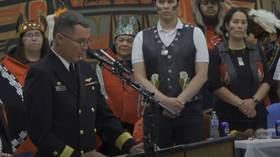US Navy apologizes for Alaska atrocity

The US Navy has offered a formal apology to the Tlingit people of southern Alaska for the destruction of the village of Angoon 142 years ago.
American warships shelled the village on October 26, 1882 as punishment for an “uprising” against a whaling company. Landing parties then torched the huts, boats, and food supplies, leaving the villagers destitute as winter approached.
“The Navy recognizes the pain and suffering inflicted upon the Tlingit people, and we acknowledge these wrongful actions resulted in the loss of life, the loss of resources, the loss of culture, and created and inflicted intergenerational trauma on these clans,” Rear Admiral Mark Sucato, head of US Navy Northwest, said at a ceremony in Angoon on the anniversary of the atrocity on Sunday.
“The Navy takes the significance of this action very, very seriously and knows an apology is long overdue,” Sucato added.
Angoon was eventually rebuilt and the Tlingit received a $90,000 settlement from the US government in 1973. Each year, however, the community would begin the remembrance ceremony by asking three times if anyone from the US Navy had come to apologize, according to AP.
“You can imagine the generations of people that have died since 1882 that have wondered what had happened, why it happened, and wanted an apology of some sort, because in our minds, we didn’t do anything wrong,” Daniel Johnson Jr., a tribal head in Angoon, told the news agency.
According to the Navy’s version of events, a Tlingit shaman called Tith Klane died when a harpoon gun exploded on a whaling ship he worked on. Members of the tribe forced the ship ashore, took hostages, and demanded 200 blankets as compensation. The whaling company refused and sought help from the military, mentioning a “Tlingit uprising.” The Tlingit maintain they never took hostages or demanded the blankets from the whalers.
Commander Edgar C. Merriman sailed down to Angoon on October 25 and demanded a tribute of 400 blankets from the Tlingit, as punishment for disobedience. When the tribe offered just 81, he ordered an attack.
“They left us homeless on the beach,” Tith Klane’s nephew, Billy Jones, said in an interview recorded in the 1950s and published in 1982. He was 13 when the village was destroyed.
Six children were among the dead, and “untold numbers of elderly and infants who died that winter of both cold, exposure and hunger,” Johnson told AP.
Rosita Worl, the head of the Sealaska Heritage Institute in Juneau, said that some of the Tlingit elders “walked into the woods” to die that winter so the younger members of the tribe would have more food.
Last month, the Navy apologized for destroying the nearby village of Kake in 1869. The US Army also plans to apologize for shelling the town of Wrangell that same year, though no date has been set yet.
The US military used force to subdue the Alaska natives after purchasing the territory from Russia in 1867, for a sum of $7.2 million (about $153.3 billion today). The acquisition was criticized until 1896, when gold was discovered in the Klondike.













